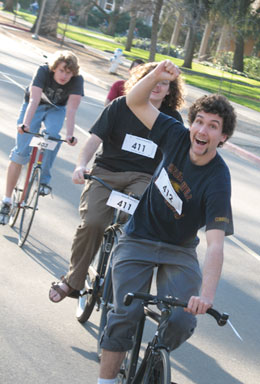Volume 24 · Number 4 · Summer 2007

(Photo: Dave Jones/UC Davis)
End Notes
For the records
Guinness World Records, here we come! An Aggie Pack’s bicycle parade in March drew 913 two-wheelers for a single-file trek through campus, setting a new world record, pending certification by the folks at Guinness. The old record was 641. The UC Davis event drew so many bicyclists, including the triumphant students at right, that the first riders finished the 2.2-mile route before the last riders left the Toomey Field staging area, said Scott Brayton, assistant athletic director for marketing.
The parade came about a month after another campus attempt at a world record, that one for the largest “flash mob” — a public gathering of a large group of people who perform some brief activity, then disperse. Organizers — who put out the word mostly via Facebook.com — said about 800 people participated, applauding and cheering customers using the ATM machines outside the Memorial Union. “The point,” student organizer Zack Crockett said in his Facebook post, “is to get people’s reactions.” The signal to begin clapping and chanting “ATM!” was the sound of the noon chimes. The group had a “secret” pass phrase: “If someone asks if you’re in the flash mob, you should respond with ‘chicken tenders are beautiful’ then you will know that they are in the mob.” Students memorialized the event with about a dozen short videos posted on YouTube — including an “official” version viewed more than 16,500 times.
Shhh!
Shields Library came away the winner in two categories in a recent California Aggie reader poll — Best Place to Study and Best Place to Sleep on Campus. Sometimes studying and sleeping are tag-team activities — as demonstrated by any number of students catnapping in the library with heads down on their books. Plus, as students and librarians noted, one attribute of the library is conducive to both pursuits — it’s quiet.
Spider sense
Super size that next hamburger order for Spider-Man — and hold the bun. He’s going to need all the protein he can get.
Making spider silk takes a lot of protein, entomology professor Lynn Kimsey told a Sacramento CBS affiliate KOVR crew that did some fact checking after the release of Spider-Man 3. “To manufacture that much [web fluid] that Spider-Man is squirting out of his wrists at every alleyway, he would have to be eating practically an entire cow every day,” she said.
Long-time fans know that in the original Marvel Comic series, Peter Parker was something of a scientific genius who, after being bitten by an irradiated spider, invented mechanical web shooters (which were prone to jamming or running out of web fluid at the most inopportune moments). In the movies, his web-shooting abilities are biological.
But even in the earliest Spider-Man stories, there was plenty to get any entomologist’s own spider senses tingling. Like that whole premise of getting special powers from a spider bite, radioactive or not. Spider venom typically paralyzes or liquefies prey (though most spider bites are harmless to humans). “So the chances of spider venom actually transforming someone into a superhero are pretty small,” Kimsey said. “Melting them, yes. Transforming them, probably not.

Barry Rice, a Nature Conservancy invasive species specialist on campus, gets a whiff of a corpse flower. (Photo: Ernesto Sandoval/UC Davis)
The nose knows
More than 3,000 people visited the Botanical Conservatory in May to see — and smell — for themselves the splendor of “Ted the Titan,” a titan arum or corpse flower that unfurled a gigantic bloom for the third time in five years. But virtual visitors checked out the flower via Web cam more than 16,000 times in just a few days — saving their noses. To attract the beetles and flies that pollinate them, Sumatran corpse flowers emit a stench like rotting flesh. Ted has since wilted and the Web cam has been disabled, but you can see scent-free photos and a time-lapse movie here. This blossom was more pungent than the last, with the scent traveling as far away as Robbins Hall, three buildings down. “He desperately wants to get pollinated and will keep trying until he does,” said Ernesto Sandoval ’96, conservatory curator. Some flies did get the message — Sandoval said the flower attracted about one fly for every 500 people who showed up.
